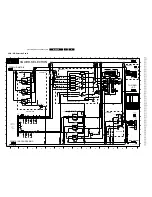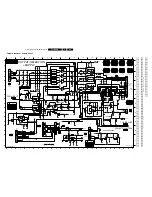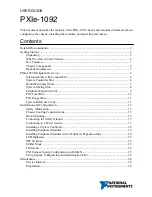
Service Modes, Error Codes, and Fault Finding
EN 33
F21RE AB
5.
•
If the picture improves after entering CSM, reduce the
sharpness value. The new value(s) are automatically
stored for all TV channels.
•
Check the SHARPNESS line. If the value is too high,
reduce the sharpness value. The new value(s) are
automatically stored for all TV channels.
Black picture and/or unstable picture
Improper signal is being received. Check the NOISE FIGURE
line. If the value is higher then 127, the signal is suspect. Check
your cable or aerial signal.
Black and white picture
Check the COLOUR line. If this value is low (<30), increase the
"Colour" value. The new value(s) are automatically stored for
all TV channels.
Menu text not sharp enough
•
Press the "Smart Picture" button on the remote control
transmitter. If the picture improves, reduce the contrast
value. The new value(s) are automatically stored for all TV
channels.
•
If the picture improves after entering CSM, reduce the
contrast value. The new value(s) are automatically stored
for all TV channels.
•
Check the CONTRAST line. If this value is high (>75),
reduce the contrast value.
5.3.2
Sound problems (only with 'speakered' FTV-monitor
connected)
No sound from left and right speaker.
Possible solutions:
•
Press the "Smart Sound" button on the remote control
transmitter. If the sound improves, raise the volume value.
The new value(s) are automatically stored for all TV
channels.
•
If the volume is acceptable after entering CSM, increase
the volume. The new value(s) are automatically stored for
all TV channels.
•
Check the VOLUME line. If the value is low, increase the
"Volume" value. The new value(s) are automatically stored
for all TV channels.
Sound too loud from left and right speaker.
•
Press the "Smart Sound" button on the remote control
transmitter. If the sound improves, reduce the volume
value. The new value(s) are automatically stored for all TV
channels.
•
If the volume is acceptable after entering CSM, decrease
the volume. The new value(s) are automatically stored for
all TV channels.
•
Check the VOLUME line. If the value is high, reduce the
"Volume" value. The new value(s) are automatically stored
for all TV channels.
5.4
ComPair
5.4.1
Introduction
ComPair (Computer Aided Repair) is a service tool for Philips
Consumer Electronics products. ComPair is a further
development of the DST (special remote control transmitter for
service), which allows faster and more accurate diagnostics.
ComPair has three big advantages:
ComPair helps you to quickly get an understanding on how to
repair the chassis in a short time by guiding you systematically
through the repair procedures.
ComPair allows very detailed diagnostics (on I2C level) and is
therefore capable of accurately indicating problem areas. You
do not have to know anything about I2C commands yourself
because ComPair takes care of this.
ComPair speeds up the repair time since it can automatically
communicate with the chassis (when the microprocessor is
working) and all repair information is directly available. When
ComPair is installed together with the Force electronic manual
of the chassis being serviced, schematics and PWBs are only
a mouse click away.
5.4.2
Specifications
ComPair consists of a Windows based faultfinding program
and an interface box between PC and the product. The
ComPair interface box is connected to the PC via a serial or
RS232 cable.
With the F21R Receiver box, the ComPair interface box and
the Receiver box communicate via a bi-directional infrared link.
The ComPair faultfinding program is able to detect and
diagnose problems occurring in the product. ComPair can
gather diagnostic information in two ways:
•
Automatic (by communication with the Receiver box):
ComPair can automatically read out the contents of the
entire error buffer. Diagnosis is done on I2C level. ComPair
can access the I2C bus of the Receiver box. ComPair can
send and receive I2C commands to the microprocessor of
the Receiver box. In this way, it is possible for ComPair to
communicate (read and write) to devices on the I2C
busses of the Receiver box.
•
Manually (by asking questions to you): Automatic
diagnosis is only possible if the microprocessor of the
Receiver box is working correctly, and only to a certain
extent. When this is not the case, ComPair will guide you
through the faultfinding tree by asking you questions (for
example, Does the screen give a picture? Click on the
correct answer: YES / NO), and showing you examples (for
example, Measure test point I7 and click on the oscillogram
you see on the oscilloscope). The servicer can answer by
clicking on a link (for example, text or a waveform picture)
that will bring you to the next step in the faultfinding
process.
By a combination of automatic diagnostics and an interactive
question and answer procedure, ComPair will enable you to
find most problems in a fast and effective way.
Beside fault finding, ComPair provides some additional
features like:
•
Uploading or downloading of presets.
•
Management of preset lists.
•
Emulation of the Dealer Service Tool (DST).
•
If both ComPair and the Force electronic service manual
are installed, all the schematics and the PWBs of the
product are available by clicking on the appropriate
hyperlink.
Example: Measure the DC-voltage on capacitor C2568
(Schematic/Panel) at the SSP.
–
Click on the "Panel" hyperlink to automatically show
the PWB with a highlighted capacitor C2568.
–
Click on the "Schematic" hyperlink to automatically
show the electronic position of the highlighted
capacitor.
5.4.3
How to Connect ComPair
1.
First, install the ComPair Browser software on your PC
(read the installation instructions carefully).
2.
Connect the RS232 interface cable between a free serial
(COM) port of your PC and the PC connector (marked
"PC") of the ComPair interface.
3.
Connect the mains adapter to the supply connector
(marked "POWER 9V DC") on the ComPair interface.
4.
Switch the ComPair interface OFF.
5.
Switch the Receiver box OFF (and remove the mains).
6.
Point the ComPair interface to the Service send-LED
(behind the cover) on the front of the Receiver box.
Содержание F21RE
Страница 7: ...Directions for Use EN 7 F21RE AB 3 3 Directions for Use ...
Страница 8: ...Directions for Use EN 8 F21RE AB 3 ...
Страница 9: ...Directions for Use EN 9 F21RE AB 3 ...
Страница 10: ...Directions for Use EN 10 F21RE AB 3 ...
Страница 11: ...Directions for Use EN 11 F21RE AB 3 ...
Страница 12: ...Directions for Use EN 12 F21RE AB 3 ...
Страница 13: ...Directions for Use EN 13 F21RE AB 3 ...
Страница 14: ...Directions for Use EN 14 F21RE AB 3 ...
Страница 15: ...Directions for Use EN 15 F21RE AB 3 ...
Страница 16: ...Directions for Use EN 16 F21RE AB 3 ...
Страница 17: ...Directions for Use EN 17 F21RE AB 3 ...
Страница 18: ...Directions for Use EN 18 F21RE AB 3 ...
Страница 19: ...Directions for Use EN 19 F21RE AB 3 ...
Страница 20: ...Directions for Use EN 20 F21RE AB 3 ...
Страница 21: ...Directions for Use EN 21 F21RE AB 3 ...
Страница 22: ...Directions for Use EN 22 F21RE AB 3 ...
Страница 23: ...Directions for Use EN 23 F21RE AB 3 ...
Страница 24: ...Directions for Use EN 24 F21RE AB 3 ...
Страница 25: ......
Страница 114: ...Revision List EN 114 F21RE AB 11 11 Revision List First release ...











































